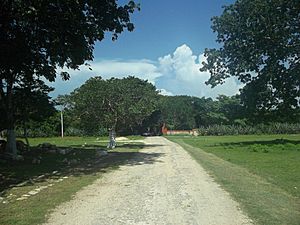Hacienda Kancabchén Ucí facts for kids
Quick facts for kids
Hacienda Kancabchén Ucí
|
|
|---|---|

Principal park at Hacienda Kancabchén Ucí
|
|
| Country | Mexico |
| Mexican States | Yucatán |
| Municipalities | Motul |
| Time zone | UTC−6 (CST) |
| • Summer (DST) | UTC−5 (CDT) |
| Postal code |
97440
|
| Area code | 991 |
Hacienda Kancabchén Ucí is a special kind of old farm or estate. It is found in the Motul Municipality in the state of Yucatán, which is in southeastern Mexico. This hacienda was built during the 1800s when a plant called henequen became very important. Many other haciendas with similar names exist in Yucatán, like Hacienda Kancabchén in Baca and Hacienda Kancabchén (Homún).
Contents
What's in a Name?
The name Kancabchén comes from the Mayan language. It means "the well of the red ground." The word Ucí means "seven." So, the full name of this place means "the seventh well of the red ground."
How to Visit
To get to Hacienda Kancabchén Ucí, you can start from Mérida. Take highway 176 northeast towards Motul. This drive is about 45 km (28 mi). The hacienda is on the road that goes from Motul to Telchac Pueblo. It is close to a ranch called Kobchen. The last 4 km (2.5 mi) to the farm can only be traveled by walking or riding a bicycle.
A Look at History
Haciendas in Yucatán have a rich history. You can learn more about them at Haciendas of Yucatán.
Records from long ago show that Benita Palma Barroso de Campos owned this property. She received eight haciendas from her husband, Roque Jacinto Campos Marrufo.
Later, in more recent times, different people owned the hacienda. Some records say Aru was the owner, while others mention Domingo Ku. Until the 1950s, the farm grew and processed henequen. Henequen is a plant used to make strong fibers for ropes and other products.
The hacienda then closed down, and its equipment was not used for many years. In the 1980s, a business person from Mérida bought some of the equipment. They started planting trees to grow limes. These limes were then processed using the old factory equipment. The first lime harvests began in the 1990s. Production was steady until a hurricane hit in 2002. This storm destroyed all the crops for that year.
In 2003, the Coca-Cola company bought the estate. They began planting new lime trees. The first harvests from these new trees started in 2010.
People of the Hacienda
Before 1937, many people lived and worked on the henequen plantations. But things changed with a new land law. President Lazaro Cardenas made a rule in 1937 called the agrarian land reform. This rule changed haciendas into collective farms called ejidos. An ejido is a piece of land that a community owns and works together.
Because of this change, only 150 hectares (370 acres) of land was left for the original owners to use as private property. After 1937, the population numbers counted people living in the wider community. The Hacienda Kancabchén Ucí itself now only houses the owner's family.
According to a count in 2005 by INEGI, 96 people lived in the community. There were 55 men and 41 women.
Photo gallery
See also
 In Spanish: Kancabchén Ucí para niños
In Spanish: Kancabchén Ucí para niños




